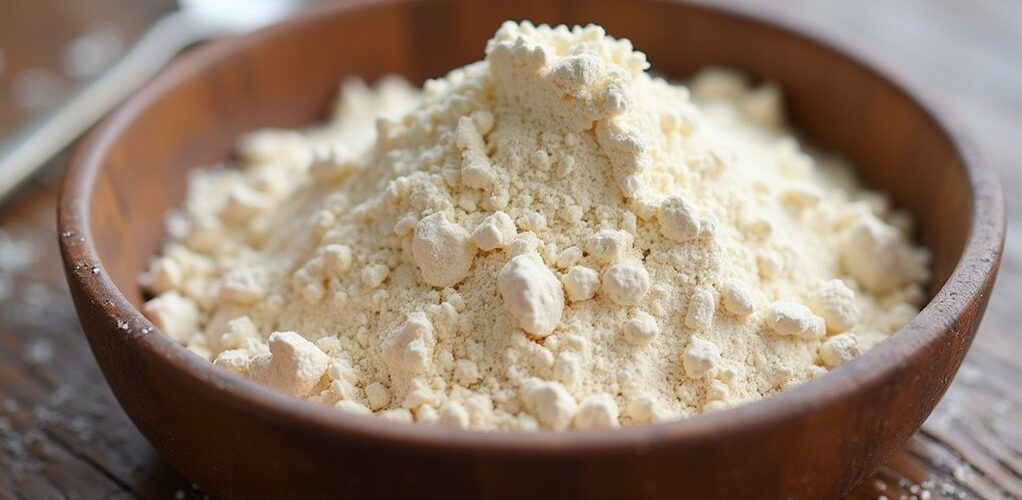
Gluten-free flour is not automatically low in carbohydrates, as many commercial gluten-free blends contain high-carb ingredients like rice flour, potato starch, and tapioca starch. While some gluten-free flours, such as almond flour (7g net carbs per quarter cup) and coconut flour (4g net carbs), offer lower-carb alternatives, others like cassava flour (30g) and rice flour (30g) pack significant carbohydrates. Understanding individual flour properties helps identify truly low-carb options for specific dietary needs.
Key Takeaways
- Gluten-free flour is not automatically low-carb, as many gluten-free flours like rice flour contain higher carbohydrates than regular wheat flour.
- Nut-based alternatives like almond flour (7g net carbs) and coconut flour (4g net carbs) are the best low-carb gluten-free options.
- Popular gluten-free substitutes like cassava flour and potato starch contain 28-30g net carbs, making them unsuitable for low-carb diets.
- Flaxseed meal contains zero net carbs and is both gluten-free and keto-friendly, making it ideal for strict low-carb diets.
- When choosing gluten-free flours for low-carb diets, focus on net carbs by subtracting fiber from total carbohydrates on nutrition labels.
Understanding the Difference Between Gluten-Free and Low-Carb
While many people associate gluten-free and low-carb diets with similar health benefits, these dietary approaches serve distinctly different purposes and can vary considerably in their carbohydrate content.
Gluten free flours, designed primarily for those with gluten intolerance, range widely in their nutritional profiles, with some containing significant amounts of carbohydrates. For example, rice flour and chickpea flour, while safely gluten-free, pack substantial carbohydrate content that may not align with a low-carb diet's goals.
Cautiously evaluate ingredient lists when selecting gluten-free products to avoid high-carb fillers and hidden sugars, which are crucial for those managing both dietary needs. Careful ingredient selection becomes essential when combining both dietary needs. While certain gluten-free options like almond flour naturally complement a low-carb diet, many gluten-free products actually contain higher carbohydrate levels than their conventional counterparts.
Understanding these distinctions helps in making informed choices that satisfy both dietary requirements effectively.
Common Types of Gluten-Free Flours and Their Carb Content
When examining gluten-free flour alternatives, the carbohydrate content varies considerably among different options, with some providing genuinely low-carb solutions while others remain high in carbohydrates.
Almond flour emerges as a popular low-carb choice with just 7 grams of net carbs per quarter cup, while coconut flour contains even fewer at 4 grams, though both offer substantially lower carbohydrate content than traditional wheat flour's 73 grams.
Flaxseed meal stands out as the lowest-carb option with zero net carbs, while alternatives like cassava flour contain higher amounts at 30 grams per quarter cup, demonstrating how gluten-free doesn't automatically mean low-carb.
Comparing Popular Flour Options
Understanding the carbohydrate content of different gluten-free flours is essential for making informed dietary choices.
When comparing popular flour options, almond flour and coconut flour emerge as excellent low carb alternatives, containing just 7 and 4 grams of net carbs per quarter cup, respectively. Chickpea flour offers moderate carbohydrate content, while being high in fiber and protein.
- Flaxseed meal stands out as the lowest-carb option with 0 net carbs, making it ideal for strict low-carb diets.
- Almond and coconut flours provide versatile alternatives with minimal carbs, perfect for everyday baking.
- Potato starch and tapioca flour rank highest in carbohydrates, with approximately 28-30 grams per serving, making them less suitable for carb-conscious consumers.
Net Carbs By Type
Net carbs in gluten-free flours showcase dramatic variations that impact their suitability for different dietary needs. Among the options, almond flour and flaxseed meal stand out as the lowest-carb alternatives, containing just 1g and 0g net carbs per 2-tablespoon serving, respectively. Coconut flour offers a moderate carb profile with 4g net carbs, while requiring additional recipe adjustments for moisture.
| Flour Type | Net Carbs (2 tbsp) | Special Notes |
|---|---|---|
| Almond | 1g | Versatile option |
| Coconut | 4g | High absorbency |
| Rice | 30g | Highest carb content |
For those following strict low-carb diets, gluten-free status alone doesn't guarantee low carb content, as evidenced by rice flour's 30g net carbs per serving. Chickpea flour falls in the middle range with 8g net carbs, while buckwheat flour contains 10g per serving.
The Science Behind Carbohydrates in Alternative Flours
The carbohydrate content in alternative flours exhibits considerable variation, with nut-based options containing substantially fewer carbs than grain-based alternatives.
Understanding how complex starches break down into simple sugars during digestion helps explain why certain gluten-free flours affect blood sugar levels differently.
The distinction between net and total carbohydrates becomes essential when selecting alternative flours, as fiber content can markedly impact the final carb count that affects blood sugar levels.
Carb Content Varies Widely
When exploring gluten-free flour options, consumers discover a striking variation in carbohydrate content across different alternatives. For those following low-carb diets, understanding these differences becomes essential for successful gluten-free baking.
While almond flour contains just 7 grams of net carbs per quarter cup, traditional wheat flour packs over 73 grams.
Key variations in carb content include:
- Nut-based flours like almond flour offer the lowest net carbs and highest protein content.
- Legume options such as chickpea flour provide moderate carb levels with 11 grams of net carbs.
- Starchy alternatives like potato and tapioca flour contain considerably higher carbohydrates.
Coconut flour emerges as another excellent low-carb choice, containing only 4 grams of net carbs per quarter cup serving, making it ideal for carb-conscious baking endeavors.
Breaking Down Complex Starches
Understanding complex starches requires exploring their molecular structure and how they break down during digestion, particularly in gluten-free flour alternatives.
Different gluten-free flours contain varying levels of complex carbohydrates, which directly impact blood sugar response. While starches like tapioca and potato have higher carbohydrate content and can cause rapid blood sugar spikes, alternatives such as almond flour offer considerably lower carbohydrate loads.
The glycemic index plays an essential role in determining how these complex starches affect blood sugar levels.
Legume-based and nut-based flours generally have lower glycemic indices, making them better choices for maintaining stable blood sugar. For instance, almond flour's complex molecular structure, combined with its high fiber content, results in slower digestion and more gradual glucose release compared to traditional wheat flour.
Net Versus Total Carbs
Measuring carbohydrates in alternative flours requires a deeper look at both total and net carb calculations, which provide essential insights for health-conscious consumers.
While total carbs represent all carbohydrates in a product, net carbs subtract fiber content, revealing the true impact on blood sugar levels.
For those pursuing weight loss or ketogenic lifestyles, understanding these distinctions becomes vital when selecting flour alternatives.
Consider these compelling differences:
- Almond flour contains just 1 gram of net carbs per serving, making it an excellent low-carb option.
- Traditional wheat flour carries 73.6 grams of total carbs, markedly impacting blood sugar.
- Some gluten-free flours, like flaxseed meal, offer zero net carbs, revolutionizing baking for carb-conscious individuals.
This understanding helps consumers make informed choices while maintaining their dietary goals.
Best Low-Carb Gluten-Free Flour Options
Several excellent low-carb alternatives exist for those seeking gluten-free flour options in their baking and cooking.
Almond flour leads the pack with just 1 gram of net carbs per 2-tablespoon serving, making it ideal for keto-friendly recipes. Coconut flour, while slightly higher at 4 grams of net carbs, offers versatility in baking when properly balanced with additional moisture.
Almond and coconut flours provide versatile, keto-friendly baking options with minimal carbs when used with proper moisture ratios.
Both flaxseed meal and chia flour contain zero net carbs per serving, with the added benefits of omega-3 fatty acids and soluble fiber, respectively.
Lupin flour stands out as a protein-rich option, containing only 1 gram of net carbs per quarter-cup serving, perfect for creating low-carb pasta and baked goods without sacrificing texture or taste.
High-Carb Gluten-Free Flours to Watch Out For
Many popular gluten-free flours pack a surprisingly high carbohydrate content that can derail health and dietary goals. Common options like rice flour, potato starch, and tapioca starch often exceed 70 grams of carbs per 100 grams, offering minimal nutritional value compared to low-carb alternatives like almond flour. When selecting gluten-free flours, be mindful of these concerning factors:
- Most rice-based flours lack adequate protein and fiber, potentially leading to increased cravings.
- Corn flour and potato starch can trigger significant blood sugar spikes, impacting insulin sensitivity.
- High-carb gluten-free flours may contribute to weight gain and metabolic issues when consumed regularly.
Additionally, refined carbohydrates such as those found in white bread and white rice rapidly convert to glucose, which can disrupt ketosis. Understanding these risks helps consumers make informed choices about their flour alternatives, particularly for those monitoring their carbohydrate intake or managing blood sugar levels.
Protein Content Comparison in Gluten-Free Flours
When examining protein content across gluten-free flours, legume-based options like chickpea flour emerge as protein powerhouses, offering approximately 7 grams per quarter-cup serving.
Nut-based alternatives, particularly almond flour with 6 grams of protein per quarter cup, stand out as excellent high-protein choices that support both nutrition and baking structure.
These protein-rich alternatives contrast sharply with conventional gluten-free options like rice flour, which contains less than half the protein at roughly 3 grams per quarter cup.
Legumes Pack Most Protein
Protein content varies considerably among gluten-free flour options, with legume-based flours leading the pack in nutritional density.
Chickpea flour and lentil flour stand out by delivering approximately 20 grams of protein per 100 grams, making them exceptional choices for low-carb baking and high-protein recipes. These alternatives also provide beneficial nutrients while maintaining lower net carbs.
When comparing protein content across gluten-free flours, three key findings emerge:
- Legume-based flours contain nearly triple the protein of rice flour
- Almond flour delivers an impressive 21% protein content
- Buckwheat flour offers a moderate 13 grams of protein per 100 grams
This substantial difference in protein content makes legume-based options particularly valuable for those seeking nutritionally dense, gluten-free alternatives in their baking endeavors.
Nuts Lead Protein Charts
Among gluten-free flour alternatives, nut-based options consistently rank highest in protein content while maintaining remarkably low carbohydrate levels. Almond flour leads the category with 6 grams of protein per 2-tablespoon serving, while containing just 1 gram of net carbs, making it an excellent low-carb choice for health-conscious consumers.
Peanut flour demonstrates even higher protein levels, providing 7 grams per 2-tablespoon serving. Additionally, flaxseed meal complements these nut-based gluten-free flours with its protein-rich profile and minimal net carbs.
This combination of high protein and low carbohydrates distinguishes nut flours from other gluten-free alternatives like rice flour, particularly in their ability to support appetite control and satiety, making them ideal for those seeking both gluten-free and low-carb options.
Impact on Blood Sugar and Glycemic Index
The glycemic impact of gluten-free flours can vary dramatically, with some options offering considerable advantages for blood sugar management. While traditional wheat flour contains high net carbs, alternative gluten-free flours like almond flour provide considerably lower carbohydrate content and better glycemic control.
The benefits of choosing low-carb, gluten-free flours include:
- Superior blood sugar regulation through higher fiber content
- Lower net carbs compared to traditional wheat flour
- Enhanced protein content from legume and nut-based options
The combination of lower glycemic index and higher protein content makes certain gluten-free flours particularly beneficial for blood sugar management. Flours derived from nuts and legumes offer improved nutritional profiles, while their fiber content helps slow sugar absorption, making them excellent choices for those monitoring their carbohydrate intake. Additionally, incorporating these low-carb food options into a diet can support individuals managing conditions like Type 2 diabetes by promoting stable blood sugar levels and improved insulin sensitivity.
Baking Tips for Low-Carb Gluten-Free Recipes
Successfully baking with low-carb gluten-free flours requires careful attention to moisture content and ingredient ratios, as these alternatives behave differently from traditional wheat flour.
When working with keto-friendly flours like almond flour and coconut flour, bakers must adjust liquid content accordingly, as these ingredients typically absorb more moisture than wheat flour.
For ideal texture and structure in low-carb baked goods, combining different flours, such as almond flour with flaxseed meal or psyllium husk powder, often yields better results.
Additionally, monitoring baking times and temperatures is essential, since almond flour tends to brown more quickly than traditional flour.
Following recipes specifically designed for low-carb gluten-free flours is recommended for beginners, as these recipes have already been tested and adjusted for successful outcomes.
Incorporating nutritious, delicious keto baking options can support weight loss and improve metabolic health while maintaining a gluten-free diet.
Nutritional Benefits Beyond Carbohydrates
While many people focus primarily on carbohydrate content when selecting gluten-free flours, these alternative ingredients offer a diverse array of nutritional benefits beyond their carb profiles.
Almond flour and coconut flour stand out as particularly nutrient-dense options, delivering essential proteins and healthy fats while maintaining low carb counts.
- Almond flour provides 6 grams of protein per 2-tablespoon serving, along with vitamin E for immune support.
- Coconut flour's high fiber content promotes digestive health and helps maintain steady blood sugar levels.
- Chickpea flour offers impressive protein content while contributing beneficial minerals to gluten-free diets.
These nutritional benefits make gluten-free flours valuable additions to a balanced diet, offering more than just carbohydrate alternatives for those seeking healthier baking options.
Making Smart Flour Choices for Different Dietary Needs
When selecting gluten-free flours for specific dietary requirements, understanding their unique properties and carbohydrate content becomes essential for making informed choices.
Individuals following low-carb diets can opt for almond flour and coconut flour, which contain considerably fewer net carbs than traditional wheat-based alternatives. These low-carb options also provide additional nutritional benefits, with almond flour offering healthy fats and coconut flour delivering high fiber content.
For those adhering to a ketogenic diet, choosing flours with a low glycemic index helps maintain stable blood sugar levels and supports ketosis.
For best baking results and balanced dietary needs, combining different gluten-free flours can create ideal texture and nutritional profiles. While nut-based flours provide protein and healthy fats, incorporating small amounts of starchier options can improve structure and mouthfeel. This strategic approach allows individuals to maintain their dietary goals while enjoying satisfying baked goods.
Combining Flours for Better Results
Creating ideal gluten-free baked goods often requires the strategic combination of multiple flour types to achieve desirable texture, flavor, and nutritional outcomes.
When blending gluten-free flours, experienced bakers focus on balancing the unique properties of each ingredient, such as combining almond flour's high protein content with coconut flour's superior moisture retention capabilities.
For best results when mixing flour combinations, consider these essential factors:
- Pair protein-rich options with starchy flours for improved texture and binding.
- Balance moisture-absorbing ingredients to prevent dryness.
- Create low-carb options by prioritizing nut-based flours.
Home-blended flour combinations offer greater control over nutritional content and texture, allowing bakers to customize their recipes while avoiding the common pitfalls of pre-made gluten-free flour blends, such as grittiness or excessive carbohydrates.
Storage and Shelf Life of Alternative Flours
Proper storage techniques play an essential role in maintaining the quality and extending the shelf life of alternative flours. When storing gluten-free flours, it's vital to take into account their varying shelf lives and storage requirements.
While starchy varieties like rice flour can last up to two years, nut-based options like almond flour require more careful handling due to their higher fat content.
Nut-based flours need extra care in storage due to high fat content, while starchy flours offer simpler, longer-lasting storage options.
For ideal long-term storage, keep gluten-free flours in airtight containers and store them in cool, dark places. Refrigeration or freezing is particularly beneficial for preserving nut-based flours, which are prone to rancidity at room temperature.
Regular monitoring for signs of spoilage, including unusual odors or color changes, helps guarantee the flour remains fresh and safe to use. Vacuum-sealed packaging provides additional protection against moisture and pests, maintaining flour quality over extended periods.
Reading Labels and Understanding Serving Sizes
Understanding nutrition labels and serving sizes stands as an essential first step in making informed decisions about gluten-free flour choices. When reading labels, consumers should focus on total carbohydrates, dietary fiber, and net carbs, calculated by subtracting fiber from total carbs. A standard serving size of 1/4 cup enables accurate comparisons between different gluten-free flours.
- Compare net carbs carefully – almond flour contains just 7g per serving, while wheat flour packs 73.6g.
- Calculate actual serving sizes in recipes to maintain proper nutritional tracking.
- Look for high-fiber options like coconut and chickpea flour to reduce net carb impact.
Understanding these elements helps consumers make informed choices about their carb intake while exploring the diverse world of gluten-free flours.
Frequently Asked Questions
Does Gluten-Free Lower the Carb Count?
Gluten-free alternatives don't automatically lower carb content. Some have considerably fewer carbs than wheat flour, while others contain more. Nutrition label insights reveal varying carbohydrate levels among different gluten-free options.
What Flour Is Best for Low Carbs?
Almond flour ranks highest for low-carb baking with only 1g net carbs per serving. Flaxseed meal and coconut flour provide nutritious alternatives, while konjac and psyllium husk offer zero-carb binding properties.
Can You Be Low-Carb and Gluten-Free?
Following low-carb diets while maintaining gluten-free options is achievable through careful meal planning and recipe adaptations. Ingredient substitutes like almond and coconut flour offer nutritional benefits while addressing both health considerations.
How Many Carbs Are in Gluten Free Flour?
Gluten-free flour carbohydrate content varies greatly by type. While almond flour contains 7g net carbs per quarter cup, starchy alternatives like potato flour have higher glycemic index and fewer beneficial nutrients for weight management.
Conclusion
While gluten-free flours offer important alternatives for those with celiac disease or gluten sensitivity, they are not inherently low in carbohydrates. Consumers should carefully examine nutritional labels and choose options like almond, coconut, or flaxseed flour for low-carb needs. Understanding the distinction between gluten-free and low-carb properties enables better dietary choices, whether for health requirements or personal nutrition goals. Smart flour selection and proper combinations can satisfy both dietary restrictions while maintaining food quality.









No Comments